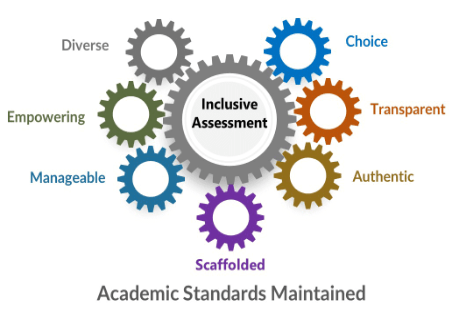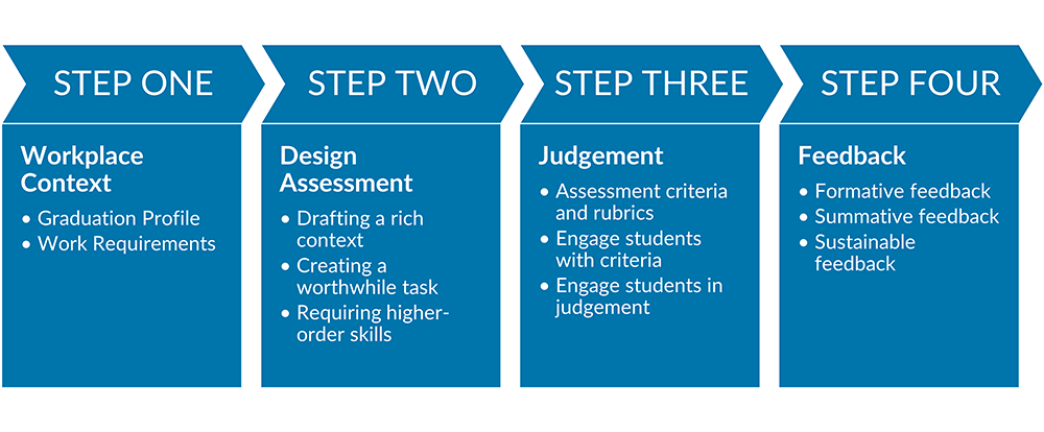Inclusive Assessment and Feedback

In this section you will find a comprehensive overview of key concepts underpinning inclusive assessment and feedback. This includes practical strategies to help you to design inclusive assessment from offering choice of assessment to diversifying the assessment methods you use, enhancing transparency and clarity through rubrics and other approaches, designing authentic assessment tasks, and ensuring that assessment is manageable. Inclusive assessment practice strives to improve learning for all students.
Assessment may be formative or summative and includes feedback. In addition to demonstrating achievement, assessment may be used to enhance learning and empower students to become self-regulated learners. For more information on the different purposes of assessment and good practice, see our Getting Started with Assessment and Feedback guide available on the UCD Teaching and Learning website.
Inclusive assessment refers to the
design and use of fair and effective assessment methods and practices that enable all students to demonstrate to their full potential what they know, understand and can do. (Hockings 2010, p. 34)
Diversity In Assessment
Using diverse methods of assessment within a module and across a programme of study provides students with different ways to demonstrate their learning, knowledge and skills.
When considering how you might diversify your assessment:
- Reflect on the level of familiarity the students may have with the new approach. Have they experienced this approach before? Ensure that students are supported throughout the module to become more familiar with this approach.
- If introducing a new approach, you may need to remove an older approach so that the students are not overloaded.
Using diverse assessment methods can support a more engaging learning experience, and allows for the effective assessment of a wider range of skills and knowledge.
Key Point
Diversifying the methods may offer a more inclusive approach to assessment and feedback practice, enabling students to demonstrate a wider range of strengths and skills. Inclusive assessment enables diverse learners to play to their strengths.

Choice of assessment
One approach to diversifying assessment is to allow students to have some choice in assessment. It allows students to play to their strengths, and can be realised through choice of assessment topics, methods, timing, questions, etc.
One very valuable approach, however, is to allow students to choose, within a module, between a choice of two or more assessment methods. A choice of two or more assessment methods capable of assessing the same module learning outcomes empowers students to take responsibility for their learning. Embedding flexibility with choice of assessment can be particularly beneficial where there are diverse learning needs in a module including (but not limited to) students with disabilities, students with different prior learning, international students, mature students, and others.
Offering choice of assessment presents an inclusive alternative to traditional approaches, such as the provision of ‘special arrangements’ intended only for certain groups of students. An assessment strategy that integrates flexibility and choice in its design supports a more equitable and inclusive approach to learning that is available to all students.
When considering the use of choice of assessment methods:
- Ensure that the choices given to the students are equitable, for example in student effort, feedback approaches, etc. The use of an Equity Template can help to achieve this.
- Prepare students to make an informed choice.
- Consider the advantages and disadvantages.
Learn More
See our Practitioner’s to Choice of Assessment to find out more about the steps to designing choice of assessment and explore UCD case studies.
Practical Tip
When considering the use of assessment rubrics:
- Reflect on the best design and most appropriate rubric to use.
- How best to set it up in Brightspace
Transparent assessment
Transparency in assessment means that students are clear about how they will be assessed and are able to understand the criteria by which their performance is evaluated. Being explicit about what is expected in the assessment and creating opportunities for students to make sense of what constitutes good quality work enhances assessment literacy which helps to support students reach their full potential.
The use of clear assessment criteria and rubrics enable students to become familiar with the requirements of the assessment and standards of good performance.
Authentic assessment
Assessment that is more engaging and relevant, often described as ‘authentic assessment’, is by its nature more inclusive.
Authentic assessment involves students performing tasks that demonstrate their ability to apply specific knowledge or skills to ‘real-world’ situations. The extent to which an assessment is authentic varies. Work-based assessment is considered to be highly authentic because students perform and are evaluated in real professional settings. Other forms of authentic assessment typically involve tasks that enable students to apply their knowledge and skills as if in a real-world situation.
Examples from different discipline include;
- Product development (entrepreneurship)
- Business plan; showcase for industry (business)
- Product design project (engineering)
- Create a patient information leaflet (health care)
- Musical performance (music)
There are a number of key features of authentic assessment, notably;
- the transfer or application of knowledge and skills to a situation or problem
- the development and evaluation of professional skills and competence
- learning is demonstrated through a performance or product
- engages students in complex learning and metacognition
- may involve collaboration
Authentic assessment is linked to higher levels of student engagement and motivation. This may be enhanced by offering students a choice of tasks connected to their own interests.

Model to Build Authentic Assessment (from Villarroel V., Bloxham S., Bruna D., Bruna C., and Constanza Herrera-Seda (2018, p. 847)
Manageability
Assessment and feedback should be manageable for both students and faculty. Overload is a common unintentional consequence of modularisation and can cause undue stress and lead to surface learning.
Evaluating overload requires careful consideration of the number of assessment tasks, assessment weightings, and time to complete tasks and deadlines in a module and across a programme.
Explore approaches to making assessment more manageable from the National Forum's guide to Assessment Of/For/As Learning. Examples include:
- Undertake a programme mapping exercise to explore the volume of assessment across a programme
- Consider reducing volume of assessment or weighting, where appropriate
- Develop integrative assessment
- Include opportunities for feedback/feedforward earlier in the trimester
- Reduce staff feedback with self and peer review exercises
- Plan the timing of your assessment with others in your team
Learn More
See the UCD Teaching and Learning guide to Assessment Workload and Equivalence to help you ensure equity in effort across assessment types.
Key Point
Scaffolding assessment is specifically aimed at supporting students to learn, practise and improve their performance through engagement with feedback. In addition to enhancing student learning, it is also used to support academic integrity.
Scaffolding of assessment
Scaffolding of assessment refers to a range of mechanisms used to support students to successfully complete an assessment task. In addition to providing students with clear assessment criteria and rubrics, the use of formative assessment is key to scaffolding and monitoring learning, enabling students to improve their performance before submitting their work for graded evaluation. While summative assessment is used to demonstrate achievement and is assigned a grade, formative assessment is typically a low-stakes or ‘no-stakes’ opportunity to effectively engage in a practice run or exercise and receive feed-forward.
Learn More
You can find more information, including a set of practical examples to help you implement this approach in this chapter on Scaffolding Assessment.
Empowering students through assessment and feedback
 In addition to providing choice of assessment, diversifying assessment, supporting students to make sense of assessment criteria and monitor their own learning, engaging with students-as-partners can include involving students directly in the design and evaluation of assessment and feedback/feedforward strategies.
In addition to providing choice of assessment, diversifying assessment, supporting students to make sense of assessment criteria and monitor their own learning, engaging with students-as-partners can include involving students directly in the design and evaluation of assessment and feedback/feedforward strategies.
This may include co-creating assessment tasks, criteria and rubrics and supporting students to generate feedback and/or feedforward on their own and their peers’ assessment.
Learn More
You can find more ideas about working with students-as-partners from building students’ assessment literacy to negotiating assessment methods and/or timing in the National Forum’s Assessment OF/FOR/AS Learning: Students as Partners in Assessment resource.
References/Bibliography
- Padden, Lisa, Tonge, Julie, Moylan, Therese and O’Neill, Geraldine (Eds) (2019) Inclusive Assessment and Feedback: Universal Design Case Studies from IADT and UCD. Dublin: UCD Access and Lifelong Learning.
- Hockings, Christine. 2010. Inclusive Learning and Teaching in Higher Education: A Synthesis of Research. EvidenceNet, Higher Education Academy.
- O’Neill, G. and L. Padden (2021): Diversifying assessment methods: Barriers, benefits and enablers, Innovations in Education and Teaching International,
- National Forum (2016) Assessment OF/FOR/AS Learning: Students as Partners in Assessment. National Forum for the Enhancement of Teaching and Learning in Higher Education. DOI: 10.6084/m9.figshare.4487762
- National Forum (2017) Authentic Assessment in Irish Higher Education, Author: Dublin
- National Forum (2017) Enhancing Programme Approaches to Assessment and Feedback in Irish Higher Education: Case Studies, Commentaries and Tools National Forum for the Enhancement of Teaching & Learning in Higher Education. Accessed 16th January 2022.DOI:10.6084/m9.figshare.5113939
- National Forum (2017) Expanding our Understanding of Assessment and Feedback in Irish Higher Education. National Forum Insight; Dublin: Author
- Villarroel Verónica, Bloxham Susan, Bruna Daniela, Bruna Carola & Herrera-Seda, Constanza (2018), Authentic assessment: creating a blueprint for course design, Assessment & Evaluation in Higher Education, 43:5, 840-854.